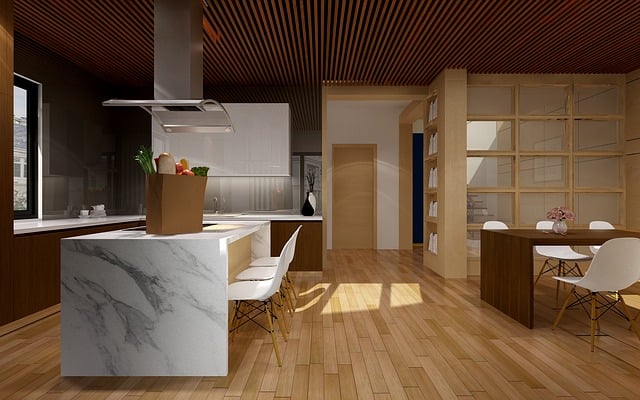When choosing kitchen flooring, consider durability and ease of maintenance. Opt for tile, hardwood, vinyl, or laminate based on your budget and aesthetic preferences. Tile and waterproof materials excel in high-traffic, moisture-prone areas. Hardwood adds warmth but demands upkeep. Vinyl and laminate offer sustainable alternatives at lower costs. Eco-friendly options like bamboo and recycled materials blend style with sustainability. Select the perfect balance between functionality, aesthetics, and sustainability for your modern kitchen.
Transform your kitchen into a maintenance-free oasis with the perfect flooring! This comprehensive guide explores various kitchen flooring options, catering to every need and style. From durable tiles and waterproof vinyl to timeless hardwood and trendy laminates, we delve into the pros and cons of each. Discover key features ensuring easy cleaning and long-lasting appeal. Additionally, explore eco-friendly choices for a sustainable, beautiful kitchen. Whether updating or designing from scratch, find your ideal modern kitchen floor materials here!
- Understanding Your Kitchen Floor Needs
- Popular Kitchen Flooring Options: Pros and Cons
- Key Features to Consider for Easy Maintenance
- Eco-Friendly Choices for Sustainable Kitchens
Understanding Your Kitchen Floor Needs
When considering kitchen flooring, understanding your specific needs is key to making an informed decision. Kitchens are high-traffic areas, subject to frequent moisture exposure from spills and steam, and often face the brunt of everyday wear and tear. Therefore, durable kitchen flooring that can withstand these challenges is essential.
Modern kitchen floor materials offer a range of options catering to various preferences and requirements. Tile flooring, for instance, provides excellent waterproof properties and easy cleaning, making it ideal for kitchens. Hardwood floors add warmth and natural aesthetics but require more maintenance. Vinyl and laminate kitchen flooring are budget-friendly alternatives, offering durability and water resistance without breaking the bank. For an eco-friendly approach, consider sustainable materials like bamboo or recycled vinyl, ensuring your kitchen floor is as kind to the environment as it is to your eyes.
Popular Kitchen Flooring Options: Pros and Cons
When it comes to choosing kitchen flooring that’s both stylish and practical, a plethora of options are available. Each material offers its unique set of advantages and disadvantages, catering to different needs and preferences.
Tile Flooring: Known for its durability and waterproof nature, tile is a popular choice for kitchens. It’s easy to clean and maintain, with various designs and colours to suit modern tastes. However, it can be cold underfoot and may require more effort when it comes to installing and arranging the tiles.
Hardwood Floors: A timeless classic, hardwood floors add warmth and character to any kitchen. They are relatively easy to clean and offer excellent durability. Yet, they might not be waterproof and can scratch or dent easily if not protected with floor mats or rugs.
Vinyl and Laminate Flooring: These synthetic options provide an affordable, low-maintenance alternative to hardwood or tile. Vinyl and laminate are waterproof, easy to install, and available in a range of realistic designs imitating wood or stone. While they may not be as durable as natural materials, they remain a popular choice for those seeking quick installation and budget-friendly solutions.
Eco-Friendly Flooring: For environmentally conscious homeowners, eco-friendly kitchen floors are gaining popularity. Materials like bamboo, cork, or recycled plastic offer sustainable options that can compete with traditional flooring in terms of durability and aesthetics.
Key Features to Consider for Easy Maintenance
When choosing kitchen flooring, consider options that offer ease of maintenance and cleaning for a spotless space. Durability is key; opt for materials that can withstand frequent foot traffic and potential spills without showing wear and tear quickly. Modern kitchen floor materials should also be resistant to water damage, making waterproof kitchen flooring an attractive choice. Tile flooring for kitchens is popular due to its versatility and ability to easily manage cleaning routines. Similarly, vinyl kitchen flooring provides a water-tight barrier while laminate kitchen flooring mimics the look of hardwood at a more affordable price point and with enhanced durability. For eco-conscious homeowners, there are various sustainable options available, ensuring you can find environmentally friendly kitchen floors without compromising on style or functionality.
Eco-Friendly Choices for Sustainable Kitchens
When considering kitchen flooring options, those with low maintenance and easy cleaning are top choices for any homeowner. Among the many durable kitchen flooring types available today, eco-friendly materials stand out as a sustainable alternative for modern kitchens. Tile flooring for kitchens offers not only water resistance but also longevity, making it an excellent pick for spaces prone to spills and moisture.
Hardwood kitchen floors have long been popular for their aesthetic appeal, but they may require more maintenance than some prefer. Vinyl and laminate kitchen flooring, however, provide a more budget-friendly option that mimics the look of wood while being highly waterproof and scratch-resistant. These materials are also easier to install and replace compared to traditional hardwood, making them ideal choices for those seeking both style and practicality in their kitchens.
When it comes to choosing the right kitchen flooring, considering ease of maintenance and cleaning is key. Opting for durable materials like tile, hardwood, or waterproof vinyl ensures long-lasting protection against stains and moisture. These modern kitchen floor materials not only offer practical benefits but also enhance the overall aesthetics of your space. For an eco-conscious approach, explore laminate or recycled options that provide both style and sustainability without compromising on durability. By selecting the right flooring, you can create a low-maintenance yet stylish kitchen environment that stands the test of time.
